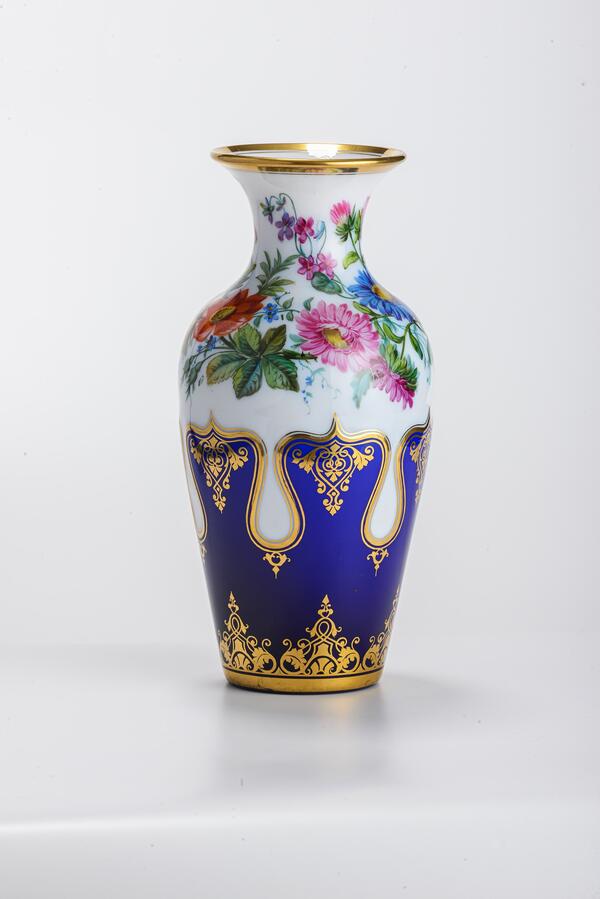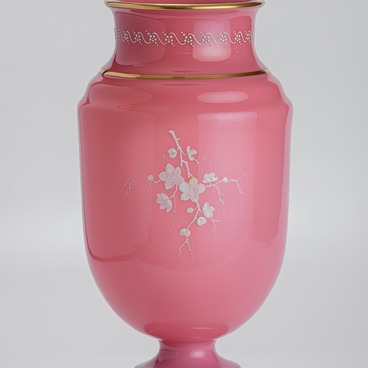The first vases in the history of mankind were molded from clay and used to store liquids and food. Centuries later, the practical function has been replaced by a decorative one: the vase has become one of the favorite decor items used for flower arrangements. The craftsmen are to make the vase attractive: it should give aesthetic pleasure, regardless of whether it supports the flowers or not. These vessels are made from a variety of materials, including glass and crystal.
The museum collection includes the best products of Russian and European factories of the 19th century. Most often, the European part of the collection was enriched with products of French and Bohemian craftsmen. The display room at the factory helped the Nikolsky glass blowers to follow the world’s artistic and technological innovations and develop their own artistic taste.
The presented flower vase is a rare example of an unusual decoration of two-layer glass, when half of the blue overlay is removed so that arches are formed. The remaining blue overlay is painted with gold patterns.
The craftsman coated the glass surface with a layer of gold not only to do the traditional edge trimming, but also as a decorative pattern. The vase was created by the craftsmen of the Baccarat factory in France.
The manufactory in Baccarat was founded by Montmorency-Laval, Bishop of Metz in 1764. For a long time, the enterprise produced only window and mirror glass, but on November 15, 1816, the first furnace for making crystal was put into operation at the factory. Since that time, production consisted mainly of tableware.
In 1832, several crystal factories (Baccarat, Saint-Louis, and Choisy-le-Roi) merged into the trading company “Launay, Hautin & Cie”. At the same time, the first illustrated catalog of the company was published.
In the second half of the 19th century, Baccarat crystal gained immense popularity due to its highly artistic qualities and technique.
In 1855, the products of “Baccarat” won a gold medal at the Paris World’s Fair.
The owners of the Nikolsko-Bakhmetevsky plant chose the best models, so the fact that a Baccarat vase appeared in their collection can be considered a sign of special recognition.
The museum collection includes the best products of Russian and European factories of the 19th century. Most often, the European part of the collection was enriched with products of French and Bohemian craftsmen. The display room at the factory helped the Nikolsky glass blowers to follow the world’s artistic and technological innovations and develop their own artistic taste.
The presented flower vase is a rare example of an unusual decoration of two-layer glass, when half of the blue overlay is removed so that arches are formed. The remaining blue overlay is painted with gold patterns.
The craftsman coated the glass surface with a layer of gold not only to do the traditional edge trimming, but also as a decorative pattern. The vase was created by the craftsmen of the Baccarat factory in France.
The manufactory in Baccarat was founded by Montmorency-Laval, Bishop of Metz in 1764. For a long time, the enterprise produced only window and mirror glass, but on November 15, 1816, the first furnace for making crystal was put into operation at the factory. Since that time, production consisted mainly of tableware.
In 1832, several crystal factories (Baccarat, Saint-Louis, and Choisy-le-Roi) merged into the trading company “Launay, Hautin & Cie”. At the same time, the first illustrated catalog of the company was published.
In the second half of the 19th century, Baccarat crystal gained immense popularity due to its highly artistic qualities and technique.
In 1855, the products of “Baccarat” won a gold medal at the Paris World’s Fair.
The owners of the Nikolsko-Bakhmetevsky plant chose the best models, so the fact that a Baccarat vase appeared in their collection can be considered a sign of special recognition.



